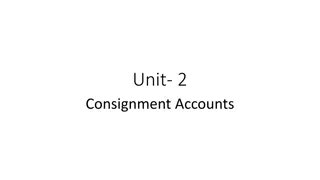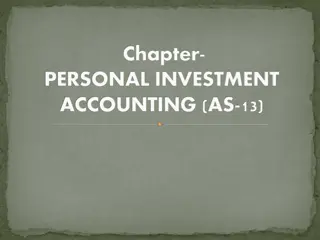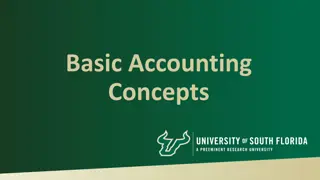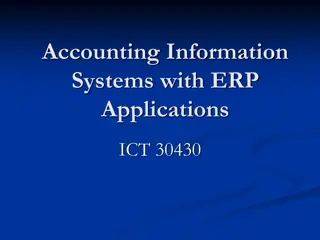Understanding Consignment in Accounting
Consignment in accounting involves sending goods from a consignor to a consignee for sale on commission basis. The consignor retains ownership until the goods are sold. The relationship is that of principal and agent, with the consignee handling sales and remitting net proceeds. Important terms include proforma invoice, consignment expenses, and different types of commissions. Tracking unsold goods and managing bad debts are crucial aspects. Objectives include expanding market reach and leveraging agent expertise.
Download Presentation

Please find below an Image/Link to download the presentation.
The content on the website is provided AS IS for your information and personal use only. It may not be sold, licensed, or shared on other websites without obtaining consent from the author. Download presentation by click this link. If you encounter any issues during the download, it is possible that the publisher has removed the file from their server.
E N D
Presentation Transcript
CONSIGNMENT ACCOUNTING CONSIGNMENT ACCOUNTING Meaning of consignment Meaning of consignment Consignment means the transaction of sending goods by one person to another, who is to sell goods on behalf of the first person. The person who sends the goods is known as consignor and the person whom the goods are sent is known as consignee. The legal relationship between these two persons is that of principal and agent. A shipment of goods by a manufacturer or wholesale dealer to an agent to be sold by him on commission basis, on the risk and account of the former , is known as consignment.. The person who sends the goods to the agent to be sold by him on commission basis is called consignor. The person to whom the goods are sent for sale on commission basis is called the consignee.
Consignor The owner of the goods who sends the goods to an agent for sale. Consignee Who sells the goods for the consignor. Sells the goods and collects the money from the customers. Will pay the consignor the net proceeds (Proceeds Expenses Commission) and provide the consignor an account sales showing all the proceeds and expenses. Consignment Consignor (Owner of the goods) Consignment account Consignee account Goods sent on Consignment account Consignee account Profit/Lose account Goods Net proceeds Consignee (Agent) Consignor account Commission Receive account
Characteristics:- 1. The relationship is that of Principal & Agent. 2. The consignee sells the goods for the commission. 3. The actual ownership of goods remain with the consignor. 4. Goods sent on consignment are the property of the consignor until the goods are sold. 5. The consignor should include all the unsold goods on consignment in his closing stock.
Objectives:- 1. To increase the sales by creating a new market for a product. 2. To get the advantage of the skill of an agent relating to a particular place. 3. To get the advantage of price differentiation of goods prevailing at different places. some important terms: Performa invoice:- consist of information relating to the nature, price, quantity, weight, minimum sale price etc. of the goods sent by the consigner. Expenses on consignment:- a)non-recurring: incurred to bring goods to the godown or place of agent e.g. freight, custom duty, insurance in transit, unloading charges. b) Recurring : incurred after the goods reached the place of consignee e.g. godown expenses, selling expenses, repair expenses, etc.
Commission:- given on amount of sales. a) Del-credere:- given on total sales to make the consignee bear the loss on account of bad debts. b) Overriding commission:- Given to make the consignee sell the goods at higher prices. It is paid as per the agreement and on the excess price. Advance amount by consignee:- may be in the form of cash, bank draft is given by consignee as security for the goods sent on consignment. Bad debts of Consignments: A consignee(agent) sells goods and collects money on behalf of the consignor. If he can t collect the debts, these debts should be treated as the bad debts of the consignor. Accounting entries in the books of the consignor: Dr Consignment Cr Consignee
Del Credere: If a consignee receives an additional commission (del credere commission), he must bear all the losses from the bad debts. In case of a bad debts arising from sales of goods on consignment, no entry is required in the books of the consignor. Accounting entries in the books of the consignee Dr Bad debts Cr Debtors (with the bad debts borne by the consignee personally) Valuation of stock If there are unsold goods on consignment at the end of the accounting period, the value of the unsold stock will be carried down to the following period. Valuation of closing stock Cost of goods unsold = xxx Add consignee expense expense/total Q*Q of unsold goods = xxx Add consignor expense expense/total Q*Q of unsold goods =xxx Total closing stock =xxx Normal lose: Normal losses are avoidable. They may rise due to natural causes like breaking in bulk, evaporation, leakage, drying etc. Abnormal lose: Abnormal losses in consignment may arise owing to reasons such as, theft, fire etc.
Illustration 1) Shri Sundaram sells 700 cases at Rs. 140 per case and incurs the following expenses: Clearing charges 850 Warehousing and storage 1,700 Packing and selling expenses 600 It is found that 50 cases have been lost in transit and 100 cases are still in transit. Shri Sundaram is entitled to a commission of 10% on gross sales. Draw up the Consignment Account and Sundaram s Account in the books of Shri Mehta. 2) Riaz Sugar Factory of Multan, consigned to Mr. Shahid of Lahore 400 bags of sugar at 25 per bag. They also paid cartage, freight, etc. 250. The consignor drew on consignee as an advance against the consignment at 3 months for 6,000 which they discounted at their bank at 5 percent. The consignee sold off the goods and rendered an account sales showing that the goods realized 12,000, out of which he deducted his charges amounting to 80 and his commission at 5 percent. Required: Required: Make journal entries in respect of the above transactions in the books of consignor as well as the consignee























